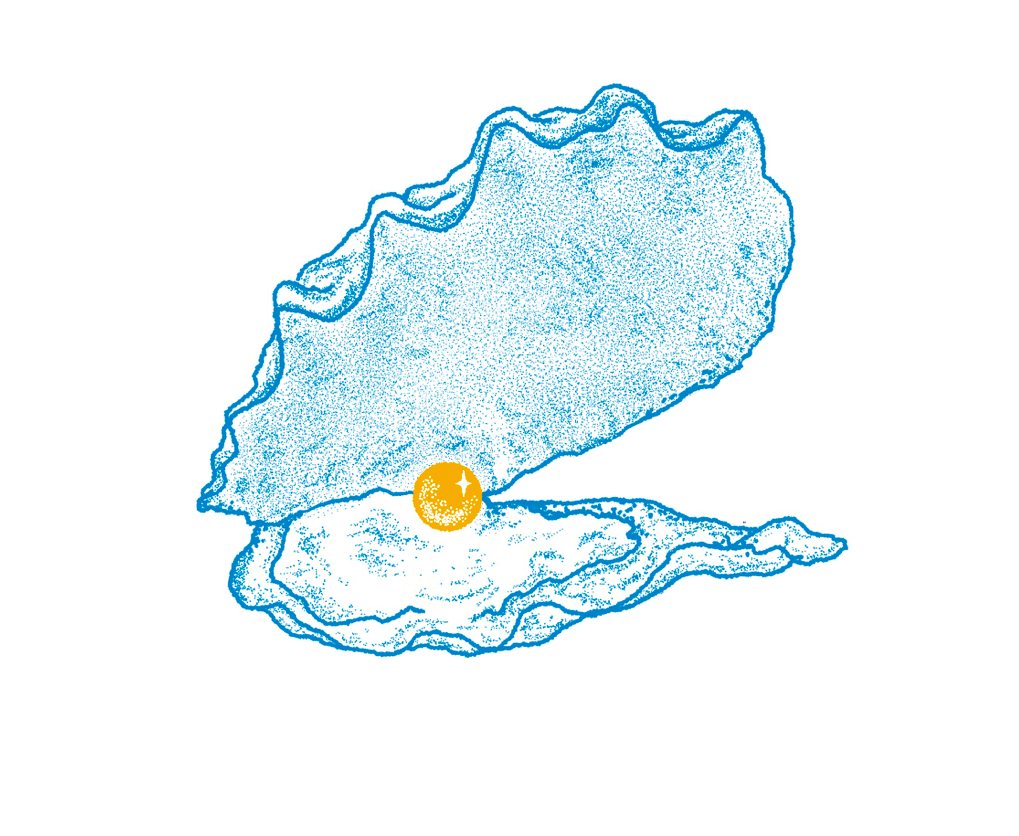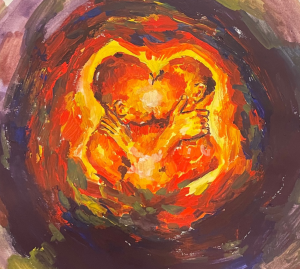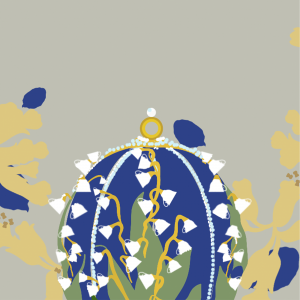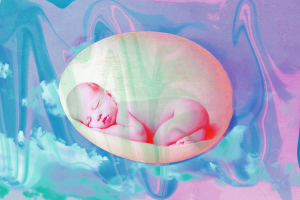
Work in Translation
by Dowon Jung | April 13, 2023
What must be done to an oyster to make it produce a pearl? Firstly, the oyster – usually bred in controlled conditions and grown in sheltered bays – is taken out of the water and sent to the pearling workshop. Workers then pry it open with a small clip. This allows them to slice into the fleshy mantle that connects the oyster’s body to its shell, where the nacre, a luminous substance that turns into the layers constituting a pearl, is produced. Next, a small bead carved from the shell of another mollusc (the nucleus), is inserted into this newly cut gap. Pieces of foreign mantle tissue cut from a donor oyster are then planted, which further encourages pearl formation. Most oysters do not survive this process, and those that do usually only do so thanks to antibiotics and a period of intensive care by pearlers who regularly scrape algae and parasites off the vulnerable oysters. Because pearls are naturally formed as a protection mechanism when an infecting irritant is introduced into a mollusc, the process of artificially creating them must inevitably be equally invasive and laborious. With the workers using tiny scalpels, hooks, and vices, pearl production resembles surgery more than it does ‘farming’.
This strange and onerous process is explored in contemporary video artist Mika Rottenberg’s film, NoNoseKnows, first shown at the 2015 Venice Biennale alongside giant burlap sacks overflowing with pearls. Set in the great pearling city of Zhuji, in southern China, the video’s narrative features two women: one white woman sitting blankly in an office full of flowers and one young Chinese woman working in the musty pearl workshops below. Throughout the video, the Chinese woman is continuously turning a crank, which powers a fan-blowing pollen into her white manager’s nose. In a rare moment of surrealism in an otherwise uncannily realist film, her sneezes magically produce plates of food, adding to an ever-growing pile of dishes which, presumably, feeds the workers below.
NoNoseKnows is ultimately a tale about globalised production. It is a tale about how resources and labour are drawn in from global peripheries for the benefit and consumption of the western metropoles. Yet, Rottenberg’s depiction of globalised production is alsomore nuanced than that. NoNoseKnows and the pearling industry more broadly, exemplify the entanglement inherent to our global age. According to anthropologist Anna Lowenhaupt Tsing, these large chains of global production and transmission depend on processes of translation. The kaleidoscopic forms of creating and assembling natural resources are transfigured to fit more neatly into systems of value, rationalised and enumerated so that these processes can be scaled, measured, and ultimately turned into profit. Tsing’s real innovation, however, is in arguing that whereas supply chains and processes of transmission and aggregation are readily scalable, the core process of production tends not to be. Translation bridges this gap. As demands from centres of global consumption for resources exponentially increase, production processes in the global peripheries are forcefully scaled through coerced labour, exploitative practices, and environmental gouging.
Pearling is an archetypal example. The basic process of pearl formation is a natural response by molluscs to prevent infections but not one that is easily scaled. To produce burlap sacks full of pearls at a time, therefore, requires a great deal of intensive labour. Efforts to forcefully scale a naturally slow and arduous process have created a whole host of entangled consequences. The vast ‘Pearl City’ of Zhuji, used as a backdrop for NoNoseKnows, is one of the more visible effects of large-scale pearl farming, as well as the rapid consolidation of corporate pearl producers in the region. Pearling, in turn, has spawned several subsidiary industries to both provide prerequisite materials and salvage leftovers. Pearl nuclei are imported from the Mississippi River; oyster sperm is collected and traded in black markets, and unused mussel shells are ground up into commercial fertilisers.
Despite this image of global connectivity, Rottenberg is clear in NoNoseKnows that this is a deeply hierarchical structure of global production. The Chinese woman turning the crank for her white manager is constantly gazing upwards at her. Meanwhile, the manager herself blankly stares forward, oblivious to the labour necessary to produce the bin bags full of pearls strewn about her office. Though the two women never meet each other, the pearl farmer below is far more intensely aware of the presence of her manager above. The white manager in NoNoseKnows is far from the Marxian caricature of an abusive and heartless exploiter. If anything, she is a laughable character in her absurdity, highlighting the tragicomedy of this entire mode of global production. Both women are intensely alienated from their own labour, only aware of their parochial operation without any knowledge of the wider implications of what they produce and consume. And this is perhaps Rottenberg’s most potent point: faceless and opaque processes of global translation do not just alienate the workers. They alienate all of us.
When I interviewed Mr Kwon, a pearl merchant trading in the jewellers’ quarter in Seoul, I found that these opaque translations happen across the supply chain. He admitted to me that he is largely unfamiliar with the journey that pearls take from their farms to the auctioneers, but after years of trading, he has developed an eye for sensing the volatile fluctuations within the pearl market. It is a relatively closed market, he says, usually entered through apprenticeships, and made all the more opaque by the fact that there are no set international standards for quality or price. Unlike diamonds and other mineral gems, where institutions like the Gemological Institute of America can set standards for measuring and assessing the products, pearls are ultimately objects borne out of organic processes. They are thus contingent upon a myriad of factors such as species, region, and weather. As such, various bodies, from farming cooperatives to auctioneers and large retailing corporations, set often contradictory standards, and inevitably, the larger players are given a bigger voice in the market. These are all part of the complex effort of translating non-human processes into human value.
These are still ongoing processes. Recently, the pearl market has undergone significant shifts. For one, the pandemic and the temporary death of in-person markets and auctions have made information about the market more limited and inaccessible to small traders like him. The lull of the pandemic has allowed some of the larger players within the market to push through some long-desired changes. Larger auctioneers like Concorde, based in Hong Kong, for whom it is profitable for individual traders to remain in the dark when it comes to prices, have recently changed their policy so that the selling price for pearls on auction is no longer released to the public, preventing merchants like Mr Kwon from accurately determining the price he should be expecting from retailers. Similarly, he notes that even considering the recent bout of inflation worldwide, the prices of pearls from other auctioneers have skyrocketed. From the fact that starting prices have not changed as significantly, he suspects that larger corporate pearl retailers are attempting to corner the market by monopolising the pearl supply. What is clear from Mr Kwon’s experience is that translation is never a static or settled process. Instead, it is both continuous and contingent, always drawing upon kaleidoscopic relations and histories.
Nevertheless, despite the apparent luxury and glamour of the product he sells, the margins for smaller traders like Mr Kwon are relatively slim. He professes that most of the value comes when the pearls are refined into their final forms by designers and fashion brands. Indeed, the jewellers’ quarter where Mr Kwon trades is located in a notoriously impoverished corner of central Seoul. There is a tragic banality to seeing Mr Kwon’s shop full of iridescent pearls squeezed in between a soup kitchen and a pawnshop.
Globalisation hides the banality and ugliness of mass production. Farms and factories now invoke images of products naturally growing or being automatically assembled when, in reality, every step of the process requires intensive human labour. We imagine oysters hanging serenely in the sea. Yet, as NoNoseKnows takes pains to show, the reality is hundreds of underpaid women scraping the flesh out of oyster shells in a damp warehouse. Algorithmic automation is not exempt from this. For instance, it has recently been revealed that ChatGPT has been relying on underpaid Kenyan workers to ensure their product is not teeming with violent and offensive content. After all, one of the primary impetuses for globalisation in the late 20th century was not a desire for transparent communication, but the outsourcing of the more unpleasant processes of production to cheaper sites overseas. Integral to this shift was the translation of values across ecologies, languages, and systems, which has had the overall effect of allowing ethically conscious consumers to be blind to how their commodities are actually produced. Pearls are just one example of this phenomenon. Ironically, it seems translation has only made the globe more opaque and illegible.
Words by Dowon Jung. Art by Frankie Frazer.




